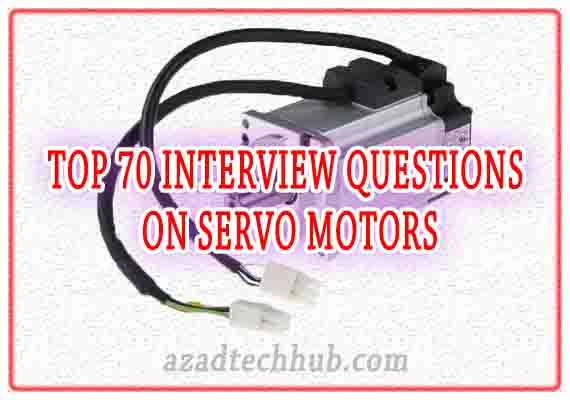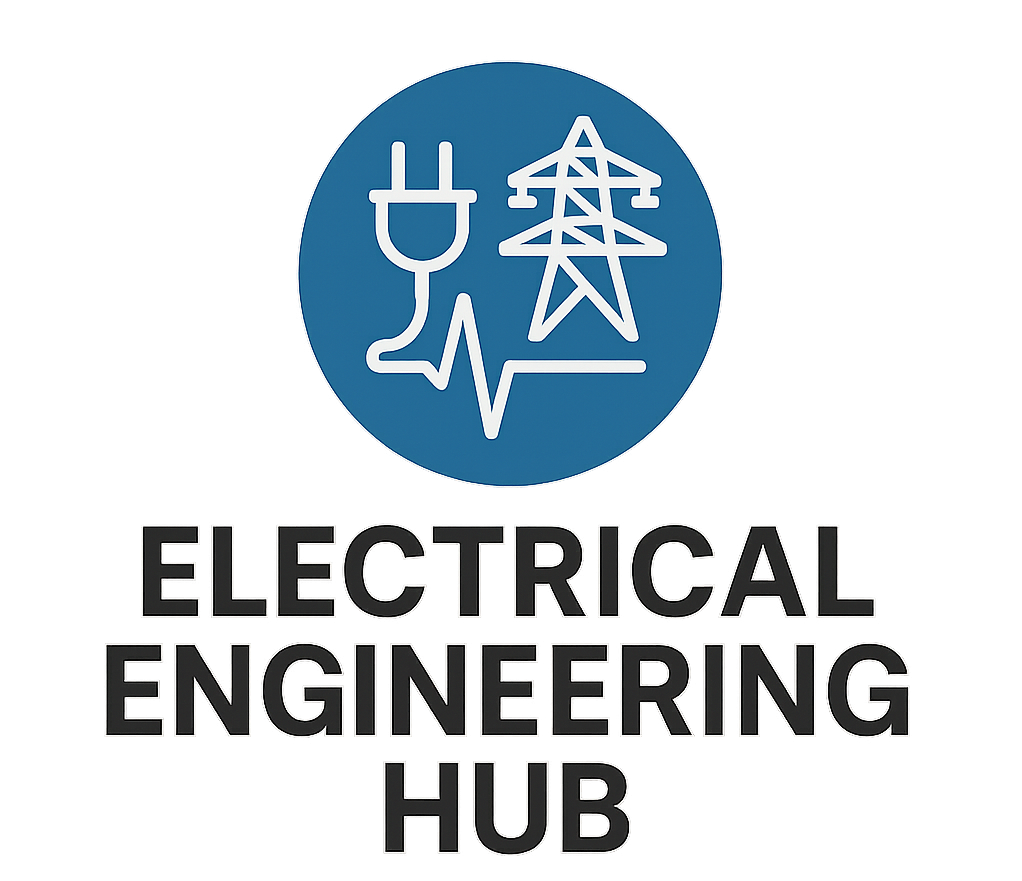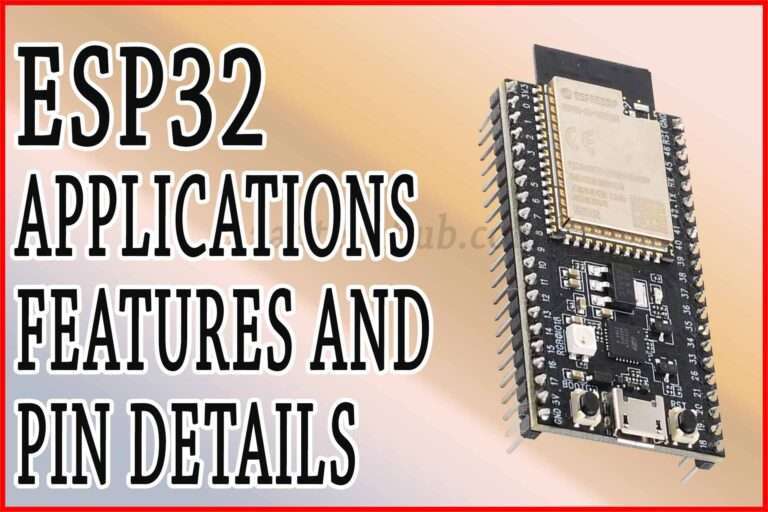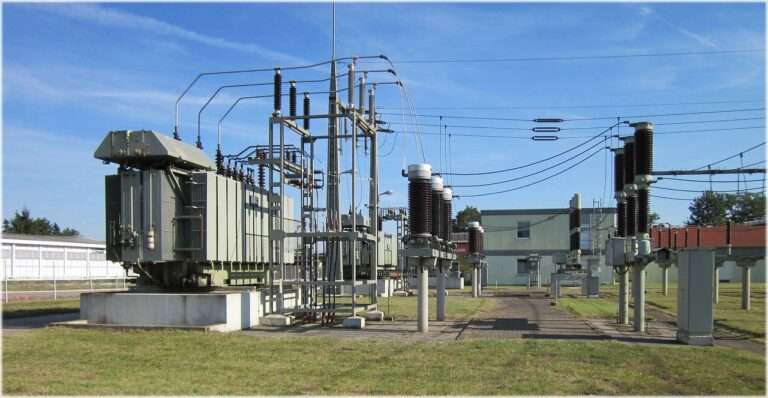Top 70 Servo Motor Interview Questions: Best Overview
In the field of electrical engineering, Servo Motor Interview Questions, play a key role for students to get their dream jobs in industries. The landscape of Servo Motor Interview Questions doesn’t just focus on technical know-how; it dives deep into a nuanced grasp and hands-on use of these incredibly precise devices that control motion. Servo motors are just a tiny part in the electrical engineering interview.
Table of Contents
As candidates prepare for these interviews, they encounter a spectrum of Servo Motor Interview Questions designed to scrutinize their expertise, problem-solving skills, and adeptness in navigating the intricate workings of servo motors.

Servo Motor Interview Questions
The landscape of Servo Motor Interview Questions encapsulates a diverse array of inquiries, spanning from the fundamental operational principles of servo motors to their sophisticated control mechanisms and applications across industries.
Candidates are tasked with unraveling the intricacies of these devices, showcasing their understanding of servo motor theory, their role in automated systems, and the ways in which these motors synchronize and regulate precise motion.
Excelling in responses to Servo Motor Interview Questions demands not only a theoretical grounding but also the ability to apply this knowledge to practical scenarios, demonstrating a holistic comprehension of these critical components in engineering systems.
1. What is a servo motor, and how does it differ from other types of motors?
A servo motor is a rotary or linear actuator that allows for precise control of angular or linear position, velocity, and acceleration. It differs from other motors by its closed-loop control system, enabling accurate and rapid responses to control signals.
2. What are the primary applications of servo motors?
Servo motors find extensive use in robotics, CNC machinery, automation systems, 3D printers, and various precision control applications requiring high accuracy and speed.
3. How does a servo motor work?
A servo motor operates with a control system comprising a feedback device (like an encoder), a controller, and the motor itself. The feedback signal continuously compares the desired position with the actual position, adjusting the motor’s rotation to minimize the error.
4. What are the key components of a servo motor system?
A servo motor system consists of the servo motor itself, a feedback device (encoder or resolver), a controller (such as a servo drive or amplifier), and often a gearbox for torque adjustments.
5. What factors should be considered when selecting a servo motor for an application?
Key considerations include torque requirements, speed range, acceleration/deceleration rates, feedback resolution, environmental conditions, and integration with the control system.
6. Can you explain the difference between open-loop and closed-loop control systems in servo motors?
An open-loop system operates without feedback, making it less precise. In contrast, a closed-loop system uses feedback to continuously adjust the motor’s performance, ensuring accuracy.

7. How does a servo motor maintain its position accurately?
The feedback device constantly provides position information to the controller. The controller compares this feedback with the desired position and adjusts the motor’s movement to minimize any discrepancy.
8. What are the advantages of using a servo motor over other types, such as stepper motors?
Servo motors offer higher precision, faster response times, smoother operation, and better performance in high-speed or high-load applications compared to stepper motors.
9. What are the different types of servo motor configurations available?
Servo motors come in various configurations, including AC and DC servo motors, brushed and brushless motors, as well as rotary and linear servo motors, each suitable for different applications.
10. How does the selection of the servo drive or amplifier impact the overall performance of the servo motor system?
The servo drive or amplifier is crucial as it interprets control signals, provides power to the motor, and influences factors like torque, speed, and accuracy of the motor.
11. What is the role of PID (Proportional-Integral-Derivative) control in servo motor systems?
PID control is a feedback loop mechanism that fine-tunes the motor’s performance by adjusting the proportional, integral, and derivative components, ensuring precise control over position and speed.
12. How does the resolution of the feedback device impact the accuracy of a servo motor?
Higher feedback device resolution provides finer position measurements, enhancing the servo motor’s accuracy in maintaining desired positions.
13. Can you explain the concept of torque ripple in servo motors and its effects?
Torque ripple refers to variations in torque output during motor operation, potentially causing vibrations and inaccuracies in motion, affecting overall system performance.
14. What measures can be taken to reduce or compensate for backlash in servo motor applications?
Backlash, or mechanical play in gears or linkages, can be minimized by using preloaded gears, electronic compensation, or tuning control algorithms to mitigate its effects.
15. How do you determine the appropriate sizing of a servo motor for an application’s torque requirements?
Sizing involves considering the load torque, acceleration, deceleration, and inertial loads, ensuring the selected servo motor meets the required performance criteria.
16. Discuss the impact of operating temperature on the performance and lifespan of servo motors.
Extreme temperatures can affect motor efficiency, insulation integrity, and lubrication, potentially reducing performance and lifespan. Proper cooling or insulation measures are essential.
17. Explain the significance of motor inertia in servo motor systems and its influence on dynamic performance.
Motor inertia affects the motor’s ability to accelerate or decelerate loads quickly. Matching inertia between the motor and load optimizes performance.
18. How does the selection of the servo motor’s communication protocol impact its integration with control systems?
Choosing compatible communication protocols like CANopen, EtherCAT, or Modbus facilitates seamless integration and communication between the servo motor and control devices.
Worth Read Posts:
19. Can you elaborate on the differences between position control and velocity control in servo motor applications?
Position control regulates the motor’s position accuracy, while velocity control focuses on maintaining a consistent speed, each catering to specific application requirements.
20. What advancements or emerging technologies are influencing the future development of servo motor systems?
Advancements in materials, miniaturization, smart sensors, and AI-driven control algorithms are shaping the future of servo motors, enhancing precision and efficiency.
21. How does a servo motor handle dynamic loads and sudden changes in load requirements?
Servo motors employ feedback systems to adapt quickly to changing loads, adjusting torque and speed to maintain precise control.
22. Can you discuss the differences between position control using absolute and incremental encoders in servo motor systems?
Absolute encoders provide the exact position information, while incremental encoders track changes in position. Absolute encoders retain position data even after power loss.
23. Explain the concept of linearity in servo motor systems and its significance in achieving accurate motion control.
Linearity refers to the consistency of the motor’s response concerning input commands, ensuring predictable and accurate movement across different command ranges.
24. What are the advantages and challenges of using closed-loop control systems in servo motor applications?
Closed-loop systems offer high accuracy and stability by continuously adjusting motor performance, but they might be susceptible to noise or system complexity.
25. How does the resolution of the servo drive impact the overall precision of the servo motor system?
Higher resolution in the servo drive allows finer adjustments to motor parameters, enhancing the system’s precision in controlling speed and position.
26. Discuss the role of backlash compensation in maintaining accuracy in servo motor-driven mechanisms.
Backlash compensation algorithms or mechanisms help counteract mechanical play, ensuring precise motion control and reducing positioning errors.
27. Can you explain the concept of torque control in servo motor systems and its importance in various applications?
Torque control regulates the motor’s torque output, crucial for applications requiring precise force control or for maintaining a consistent force during operation.
28. How does the choice between analog and digital servo drives impact the performance and flexibility of a servo motor system?
Analog drives offer simplicity, while digital drives provide advanced features and greater configurability, catering to different control system requirements.
29. Discuss the factors influencing the selection of the motor’s feedback device, such as encoders or resolvers, in servo motor applications.
Factors like resolution, accuracy, cost, environmental robustness, and compatibility with control systems influence the choice of feedback devices.
30. What advancements or innovations in servo motor technology are enhancing their capabilities in industrial automation and robotics?
Advancements in high-torque density, precision control algorithms, miniaturization, and integration with IoT technologies are revolutionizing servo motor applications in automation and robotics.
31. How does the choice between synchronous and asynchronous servo motors impact their performance in different applications?
Synchronous servo motors offer higher efficiency and precision, suitable for applications demanding accurate positioning, while asynchronous motors might be more cost-effective for general-purpose applications.
32. Explain the concept of torque control modes, such as torque, speed, and position control, in servo motor systems.
Torque control regulates the motor’s output force, speed control maintains a constant velocity, and position control ensures precise positioning, each addressing specific control requirements.
33. Can you elaborate on the role of gear ratios in servo motor applications and their impact on torque and speed?
Gear ratios in the transmission system adapt the motor’s torque and speed output to match the load requirements, enhancing the system’s overall performance.
34. Discuss the significance of servo motor tuning or parameterization in optimizing its performance for specific applications.
Servo motor tuning involves adjusting control parameters to optimize responsiveness, stability, and accuracy, aligning the motor’s performance with the application’s needs.
35. How does the choice of motor feedback resolution influence the accuracy and precision of servo motor control?
Higher feedback resolution enables finer position control, enhancing the motor’s accuracy and precision in meeting desired position or velocity requirements.
36. Explain the impact of electrical resonance in servo motor systems and measures to prevent or mitigate its effects.
Electrical resonance can lead to instability and increased noise in the system. Techniques like damping or filtering can help mitigate resonance issues.
37. Can you discuss the advantages and limitations of using servo motors in robotics and automation?
Servo motors offer high precision, speed, and flexibility in robotics and automation but might face limitations concerning cost and complexity in certain applications.
38. What role do peak and continuous current ratings play in selecting a servo motor for specific applications?
Peak current ratings indicate the motor’s short-term maximum capability, while continuous ratings define its sustained operational capacity, influencing motor selection for varying load demands.
39. Explain the concept of torque ripple in servo motor systems and its effects on mechanical components.
Torque ripple causes variations in motor torque output, potentially leading to vibrations or stress on mechanical components, affecting system stability and precision.
40. What are the factors influencing the selection of the appropriate servo motor cooling method in different environments?
Factors like ambient temperature, duty cycle, and motor power ratings dictate the choice between air cooling, liquid cooling, or fan-assisted cooling methods for optimal motor performance.
41. How does a servomotor maintain its accuracy and precision in high-speed applications compared to low-speed operations?
Servomotors use feedback control systems to adjust their response based on speed requirements, maintaining accuracy regardless of the operational speed.
42. Can you explain the importance of encoder resolution and counts per revolution in servo motor applications?
Encoder resolution, often measured in counts per revolution, determines the level of precision and granularity in position feedback, directly impacting motor control accuracy.
43. Discuss the advantages and disadvantages of using linear servo motors compared to rotary servo motors.
Linear servo motors offer direct linear motion without mechanical conversions, but they may face challenges in load handling and integration compared to rotary servo motors.
44. What are the key differences between velocity and acceleration control in servo motor applications?
Velocity control regulates motor speed, while acceleration control manages the rate of change in speed, each crucial for achieving specific motion profiles.
45. Explain the role of the servo motor’s torque constant and its significance in motor selection.
The torque constant indicates the motor’s torque production per ampere of current, helping assess the motor’s torque capabilities and efficiency.
46. How does the choice of feedback device, such as optical or magnetic encoders, impact the servo motor’s performance and reliability?
The selection of feedback devices influences accuracy, resolution, susceptibility to environmental factors, and overall reliability of servo motor systems.
47. Discuss the methods used for backlash compensation in servo motor systems and their effectiveness.
Backlash compensation mechanisms can include software-based algorithms or physical mechanisms to counteract mechanical play, ensuring accurate positioning.
48. Can you elaborate on the advantages and limitations of using closed-loop control systems in high-performance servo motor applications?
Closed-loop systems offer high precision but might face challenges with added complexity, cost, and susceptibility to external disturbances.
49. Explain the concept of servo motor bandwidth and its relevance to servo system performance.
Servo motor bandwidth represents the range of frequencies the motor can respond to, influencing its ability to follow command signals accurately and swiftly.
50. How does regenerative braking in servo motors contribute to energy efficiency and system performance?
Regenerative braking allows the servo motor to recover energy during deceleration, reducing energy consumption and improving overall system efficiency.
51. What role does the inertia ratio play in optimizing servo motor performance for specific applications?
The inertia ratio between the motor and load affects the motor’s ability to control and respond to changes in load, impacting overall system performance.
52. Discuss the impact of electrical noise and interference on servo motor systems and measures to mitigate these effects.
Electrical noise can disrupt feedback signals, affecting motor control. Shielding, filtering, and proper grounding help reduce interference in servo motor systems.
53. Can you elaborate on the differences between position control using absolute and incremental encoders in servo motor applications?
Absolute encoders provide precise position information, while incremental encoders detect changes in position. Absolute encoders retain position data even after power loss.
54. How does the choice between field-oriented control (FOC) and direct torque control (DTC) influence servo motor system performance?
Field-oriented control offers smoother operation and better efficiency, while direct torque control provides faster dynamic response and simpler implementation.
55. Explain the role of servo motor gain tuning in achieving optimal system performance and stability.
Servo motor gain tuning involves adjusting control parameters to optimize system response, ensuring stability, minimizing oscillations, and enhancing accuracy.
56. Discuss the significance of resolver-based feedback systems in servo motor applications compared to encoders.
Resolvers offer robustness in harsh environments and better resistance to temperature and vibration but may have slightly lower resolution compared to encoders.
57. How does the choice between analog and digital control signals impact the precision and flexibility of servo motor systems?
Digital control signals offer higher accuracy, noise immunity, and flexibility in programming, while analog signals might be simpler but more susceptible to interference.
58. Can you explain the importance of overshoot and settling time in servo motor control systems?
Overshoot refers to the initial transient response exceeding the desired value, while settling time represents the duration for the system to stabilize within an acceptable range.
59. Discuss the factors influencing the selection between a linear servo motor and a traditional ball screw system in precision applications.
Linear servo motors offer faster response and high accuracy but may face limitations in cost or load-carrying capacity compared to traditional ball screw systems.
60. How do advanced control algorithms, such as predictive control or adaptive control, enhance servo motor system performance?
Advanced control algorithms improve accuracy, responsiveness, and adaptability to varying conditions, optimizing servo motor performance in complex applications.
61. Explain the impact of cogging torque in servo motor systems and methods to minimize its effects.
Cogging torque causes irregular motion and affects precision. Techniques like motor design optimization or compensation algorithms can reduce cogging effects.
62. Can you discuss the role of motor inertia matching in optimizing servo motor performance?
Matching motor and load inertia ensures smoother motion, faster response, and minimizes overshoot, optimizing the servo motor system’s performance.
63. Explain the relationship between PID control parameters (Proportional, Integral, Derivative) and servo motor system response.
PID parameters adjust the system’s response to errors; proportional contributes to immediate response, integral minimizes steady-state errors, and derivative manages response rates.
64. Discuss the advantages of using field-oriented control (FOC) for high-performance servo motor applications.
FOC offers precise control over torque and speed, reduces torque ripple, and enhances efficiency, making it suitable for high-performance applications.
65. Can you elaborate on the concept of torque control and its significance in servo motor-driven mechanisms?
Torque control manages the motor’s force output, crucial for applications demanding precise force regulation or maintaining consistent force during operation.
66. Explain the process of selecting the appropriate gearbox ratio for a servo motor-based system.
Selecting gearbox ratios involves considering speed reduction requirements, torque multiplication, and matching motor speed with load requirements for optimal performance.
67. Discuss the influence of temperature compensation in maintaining servo motor accuracy across varying operating conditions.
Temperature compensation adjusts control parameters based on temperature variations, ensuring consistent motor performance in different environmental conditions.
68. Can you explain the benefits of using backlash elimination techniques in precision servo motor applications?
Backlash elimination techniques reduce mechanical play, improving motion accuracy, minimizing positioning errors, and enhancing overall system precision.
69. Discuss the role of commutation methods, such as sinusoidal or trapezoidal commutation, in servo motor performance.
Commutation methods determine how motor phases are energized, affecting motor smoothness, efficiency, and torque output in different operating conditions.
70. How does the implementation of safety features, such as torque limiting or emergency stop, enhance servo motor system reliability?
Safety features prevent excessive loads, overloading, or emergency situations, safeguarding the motor and system components from potential damage.
Know more about how to select overload relay for motor
Tackling Servo Motor Interview Questions is like diving into the deep end of a pool full of tricky but fascinating puzzles. These questions aren’t just about knowing the right answers; they’re about showing how we think, solve problems, and understand these cool little motors that make things move precisely.
Whether it’s about their functions, how they’re controlled, or where they’re used, answering Servo Motor Interview Questions is like putting together pieces of a big puzzle about these motors.
Getting ready for Servo Motor Interview Questions isn’t just for the interview itself; it’s about getting really good at understanding servo motors and how they work in real life. These questions help us see the bigger picture and how important these motors are in all sorts of machines and gadgets we use every day.
So, when we tackle these questions, we’re not just prepping for an interview; we’re gearing up to become pros who know these motors inside out, ready to jump into the exciting world of engineering where these motors are total game-changers.
Follow Us on Social:
Subscribe our Newsletter on Electrical Insights for latest updates from Electrical Engineering Hub
#ServoMotor, #ServoMotorInterview, #EngineeringJobs, #MechanicalEngineering, #ElectricalEngineering, #AutomationEngineering, #MotorControl, #ServoTechnology, #TechInterviewPrep, #EngineeringInterview, #RoboticsEngineering, #Mechatronics, #ServoBasics, #EmbeddedSystems, #MotorInterviewQuestions




